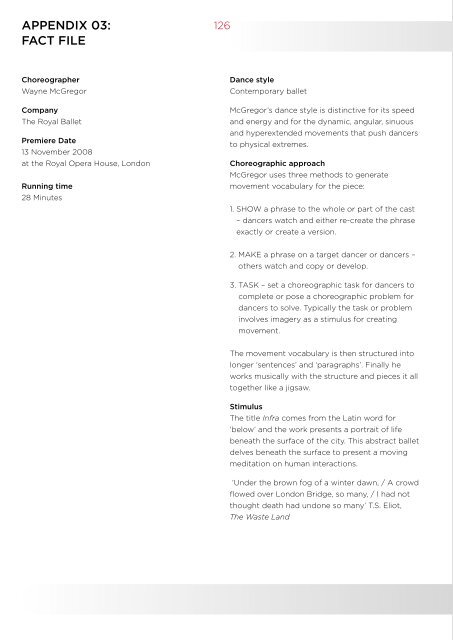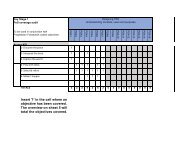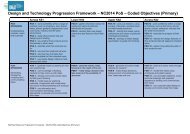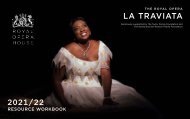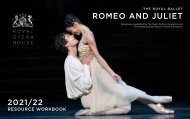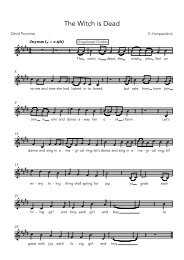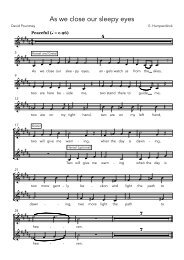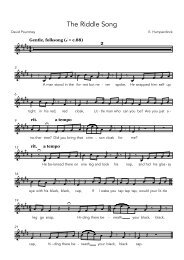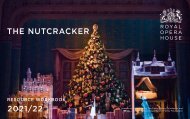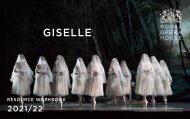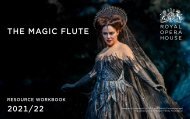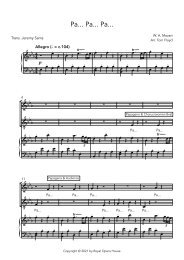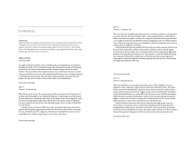Infra E-resource pack 2018
You also want an ePaper? Increase the reach of your titles
YUMPU automatically turns print PDFs into web optimized ePapers that Google loves.
APPENDIX 03:<br />
FACT FILE<br />
126<br />
Choreographer<br />
Dance style<br />
Choreographic intention<br />
Costume<br />
Wayne McGregor<br />
Contemporary ballet<br />
<strong>Infra</strong> is about seeing below the surface of things.<br />
Costume designs by Moritz Junge.<br />
Company<br />
The Royal Ballet<br />
Premiere Date<br />
13 November 2008<br />
at the Royal Opera House, London<br />
Running time<br />
28 Minutes<br />
McGregor’s dance style is distinctive for its speed<br />
and energy and for the dynamic, angular, sinuous<br />
and hyperextended movements that push dancers<br />
to physical extremes.<br />
Choreographic approach<br />
McGregor uses three methods to generate<br />
movement vocabulary for the piece:<br />
Quite literally, in this case, below Julian Opie’s<br />
design. You can see people, walking in the street.<br />
<strong>Infra</strong> is about people and the choreography uses a<br />
pedestrian language which is recognizably human.<br />
When you look at a body on stage, you have<br />
some understanding of what that body is doing.<br />
The piece is about inferences. It infers particular<br />
types of relationships and therefore the emotional<br />
content implies itself.<br />
Fitted shorts, vests, t-shirts in flesh, black, white,<br />
grey colours for the dancers. One female dancer<br />
wears a short wrap-around skirt. One male dancer<br />
wears long trousers. The females wear pointe<br />
shoes.<br />
Street clothes for the brief appearance of the<br />
crowd.<br />
1. SHOW a phrase to the whole or part of the cast<br />
– dancers watch and either re-create the phrase<br />
exactly or create a version.<br />
2. MAKE a phrase on a target dancer or dancers –<br />
others watch and copy or develop.<br />
One of McGregor’s choreographic aims is to help<br />
the audience’s eye in watching a complex structure.<br />
But in <strong>Infra</strong>, McGregor has purposefully left open<br />
the full visual field to let the audience make their<br />
own selections.<br />
Lighting<br />
Lighting design by Lucy Carter, with whom<br />
Wayne McGregor has developed a strong creative<br />
partnership.<br />
The lighting, which relates closely to the structure,<br />
lights the width of the stage and often focusses<br />
3. TASK – set a choreographic task for dancers to<br />
Dancers<br />
downstage. Occasionally dancers are lit by shafts<br />
complete or pose a choreographic problem for<br />
12 dancers (6 male / 6 female)<br />
of light and at one point six rectangles of light<br />
dancers to solve. Typically the task or problem<br />
involves imagery as a stimulus for creating<br />
Brief appearance of a crowd who cross the stage<br />
frame six duets. Colours are used to highlight<br />
different sections.<br />
movement.<br />
Structure<br />
Physical Setting<br />
The movement vocabulary is then structured into<br />
longer ‘sentences’ and ‘paragraphs’. Finally he<br />
works musically with the structure and pieces it all<br />
together like a jigsaw.<br />
Stimulus<br />
The title <strong>Infra</strong> comes from the Latin word for<br />
‘below’ and the work presents a portrait of life<br />
beneath the surface of the city. This abstract ballet<br />
Episodic. The ballet comprises solos, duets and<br />
ensembles with many arresting moments: for<br />
instance, 6 couples dance duets in six squares of<br />
light and a crowd surges across the stage, unaware<br />
of one woman’s private grief.<br />
Aural Setting<br />
Music by Max Richter (performed by The Max<br />
Richter Quintet with Jonathan Haswell).<br />
Proscenium arch/theatrical setting.<br />
Set<br />
Set design by artist Julian Opie.<br />
An 18m LED screen is placed high on the black<br />
back wall. It runs the width of the stage, along<br />
which there is a mesmerizing flow of electronic<br />
walking figures.<br />
delves beneath the surface to present a moving<br />
meditation on human interactions.<br />
Sound design by Chris Ekers.<br />
‘Under the brown fog of a winter dawn, / A crowd<br />
The score mixes melancholy string melodies with<br />
flowed over London Bridge, so many, / I had not<br />
electronic sounds and everyday sounds such as<br />
thought death had undone so many’ T.S. Eliot,<br />
train whistles.<br />
The Waste Land


